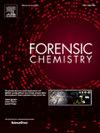Recovery and detection of ignitable liquid residues from the substrates by solid phase microextraction – direct analysis in real time mass spectrometry
IF 2.6
3区 医学
Q2 CHEMISTRY, ANALYTICAL
引用次数: 0
Abstract
In this study, direct analysis in real time mass spectrometry (DART-MS) was coupled to the solid phase microextraction (SPME) to extract and analyze the ignitable liquid residues (ILR) present in the sample matrices. The SPME extraction parameters, such as extraction temperature and extraction time, were optimized using a two-factor central composite design. The SPME-DART-MS setup was utilized to analyze the substrates and fire debris matrices spiked with gasoline. The results indicate that the less volatile marker compounds from gasoline were recovered from the substrates and fire debris, and their profiles matched well with the gasoline liquid samples analyzed directly by DART-MS. As expected, the effective extraction of marker compounds in gasoline required a relatively high temperature, i.e., 150 ℃. In the presence of a matrix, a higher extraction temperature and longer extraction time could benefit the extraction efficiency. The desorption of ILR on SPME fiber was performed by inserting the fiber into the DART-MS helium gas stream at 300 ℃ for 1 min with no carry-over residues being observed between successive samples. The chemical information attained with this method is typically not observed in the current GC/MS-based practice. The SPME-DART-MS was also extended to reanalyze less volatile components of ILR on substrates after the ASTM E1412 activated charcoal method, which indicates its possible application subsequent to the traditional GC/MS ILR analysis. The SPME-DART-MS has shown promise in ILR detection as an important complementary tool.
通过固相微萃取--实时质谱直接分析--回收和检测底物中的可燃液体残留物
本研究将直接分析实时质谱法(DART-MS)与固相微萃取法(SPME)相结合,对样品基质中的可燃液体残留物(ILR)进行萃取和分析。采用双因素中心复合设计优化了 SPME 的萃取参数,如萃取温度和萃取时间。利用 SPME-DART-MS 装置对添加了汽油的基质和火灾残骸基质进行了分析。结果表明,从基质和火灾残骸中回收到了挥发性较低的汽油标记化合物,而且其特征与直接用 DART-MS 分析的汽油液体样品十分吻合。正如预期的那样,有效萃取汽油中的标记化合物需要相对较高的温度,即 150 ℃。在存在基质的情况下,更高的萃取温度和更长的萃取时间会提高萃取效率。将 SPME 纤维插入 300 ℃ 的 DART-MS 氦气流中 1 分钟,即可解吸 SPME 纤维上的 ILR,且在连续样品之间观察不到携带残留物。这种方法所获得的化学信息通常是目前基于气相色谱/质谱法所无法观察到的。在使用 ASTM E1412 活性炭法之后,SPME-DART-MS 还可用于重新分析基质上挥发性较低的 ILR 成分,这表明它可以在传统的 GC/MS ILR 分析之后继续使用。作为一种重要的补充工具,SPME-DART-MS 在检测 ILR 方面已显示出良好的前景。
本文章由计算机程序翻译,如有差异,请以英文原文为准。
求助全文
约1分钟内获得全文
求助全文
来源期刊

Forensic Chemistry
CHEMISTRY, ANALYTICAL-
CiteScore
5.70
自引率
14.80%
发文量
65
审稿时长
46 days
期刊介绍:
Forensic Chemistry publishes high quality manuscripts focusing on the theory, research and application of any chemical science to forensic analysis. The scope of the journal includes fundamental advancements that result in a better understanding of the evidentiary significance derived from the physical and chemical analysis of materials. The scope of Forensic Chemistry will also include the application and or development of any molecular and atomic spectrochemical technique, electrochemical techniques, sensors, surface characterization techniques, mass spectrometry, nuclear magnetic resonance, chemometrics and statistics, and separation sciences (e.g. chromatography) that provide insight into the forensic analysis of materials. Evidential topics of interest to the journal include, but are not limited to, fingerprint analysis, drug analysis, ignitable liquid residue analysis, explosives detection and analysis, the characterization and comparison of trace evidence (glass, fibers, paints and polymers, tapes, soils and other materials), ink and paper analysis, gunshot residue analysis, synthetic pathways for drugs, toxicology and the analysis and chemistry associated with the components of fingermarks. The journal is particularly interested in receiving manuscripts that report advances in the forensic interpretation of chemical evidence. Technology Readiness Level: When submitting an article to Forensic Chemistry, all authors will be asked to self-assign a Technology Readiness Level (TRL) to their article. The purpose of the TRL system is to help readers understand the level of maturity of an idea or method, to help track the evolution of readiness of a given technique or method, and to help filter published articles by the expected ease of implementation in an operation setting within a crime lab.
 求助内容:
求助内容: 应助结果提醒方式:
应助结果提醒方式:


